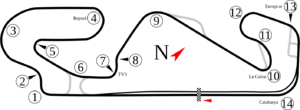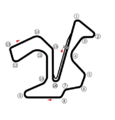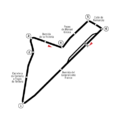Spanish Grand Prix facts for kids
| Circuit de Barcelona-Catalunya | |
 |
|
| Race information | |
|---|---|
| Number of times held | 66 |
| First held | 1913 |
| Most wins (drivers) | |
| Most wins (constructors) | |
| Circuit length | 4.657 km (2.894 mi) |
| Race length | 307.236 km (190.908 mi) |
| Laps | 66 |
| Last race (2025) | |
| Pole position | |
|
|
| Podium | |
|
|
| Fastest lap | |
|
|
The Spanish Grand Prix is a famous Formula One car race. It is currently held at the Circuit de Barcelona-Catalunya in Spain. This race is one of the oldest in the world. It celebrated its 100th birthday in 2013!
The Spanish Grand Prix started as a race for regular cars. After a break for World War I, it became a regular event in Europe. It joined the European Championship in 1935. Racing stopped during the Spanish Civil War. The race came back in 1967. It has been a regular part of the Formula One World Championship since 1968.
The race is planned to stay at the Circuit de Barcelona-Catalunya until 2025. In 2026, the Spanish Grand Prix will move to a new street circuit near Madrid. The Barcelona race will then be called the Barcelona-Catalunya Grand Prix.
Contents
The Exciting History of the Spanish Grand Prix
How the Race Began
The first race called a Spanish Grand Prix happened in 1913. It was a race for touring cars. The race took place on a 300-kilometer road near Madrid. Carlos de Salamanca won this first race in a Rolls-Royce.
Before this, other car races happened in Spain. The Catalan Cup was held from 1908 to 1910. These races helped Spain become a strong racing country. This led to building a special track called Sitges-Terramar. The first official Spanish Grand Prix was held there in 1923. Albert Divo won that race.
Racing at Lasarte
After the first race, the Sitges-Terramar track had money problems. So, the Spanish Grand Prix moved to the Circuito Lasarte in 1926. This track was near Bilbao. The 1927 Spanish Grand Prix was part of a world championship. But the race was still new. In 1928 and 1929, it was a sports car race.
The 1930 race was canceled because of money problems. The race was also canceled in 1931 and 1932. Finally, in 1933, the Spanish Grand Prix returned at Lasarte. After the 1935 race, the Spanish Civil War began. Racing stopped again. In 1946, racing came back to Spain. This was with the Penya Rhin Grand Prix in Barcelona.
Formula One Era: Modern Racing Begins
Pedralbes Circuit: Early F1 Years
Spain rejoined the international racing calendar in 1951. It became part of the Formula One championship. This race was on the wide Pedralbes street circuit in Barcelona. Juan Manuel Fangio won his first world championship there in 1951.
The race was planned for 1952 and 1953 but did not happen. This was due to a lack of money. In 1954, Mike Hawthorn won in a Ferrari. The 1955 Spanish Grand Prix was canceled. A terrible accident at another race led to new safety rules. The Pedralbes track was never used for racing again.
Jarama and Montjuïc: Alternating Tracks
In the 1960s, Spain wanted to bring back international racing. A new track was built north of Madrid called Jarama. The Montjuïc street circuit in Barcelona was also improved. A non-championship race happened at Jarama in 1967. Jim Clark won it.
In 1968, Jarama hosted the Spanish Grand Prix. It was decided the race would switch between Jarama and Montjuïc. Jarama was tight and twisty. Montjuïc was fast and wide. Jackie Stewart won the first F1 race at Montjuïc in 1969.
The 1975 race at Montjuïc had a sad event. Drivers were worried about safety barriers. They were not properly fastened. Drivers refused to race at first. But they eventually started. During the race, Rolf Stommelen's car crashed. Four spectators died. The race was stopped early. Jochen Mass won, but only half points were given.
Jarama: The Sole Host
After the Montjuïc tragedy, the Spanish Grand Prix stayed at Jarama. In 1976, James Hunt won. He was disqualified at first because his car was too wide. But McLaren appealed, and his win was given back. Mario Andretti dominated in 1977 and 1978.
The 1980 race was unusual. It was not counted as a championship race. Many factory teams did not show up. Alan Jones won for Williams. The 1981 race was famous. Gilles Villeneuve won in his Ferrari. He held off four faster cars on the twisty track. This is seen as one of the best drives ever. The Spanish Grand Prix left Jarama after 1981. It returned in 1986.
Jerez: A New Southern Track
A new track was built in Jerez in 1985. It was called the Circuito Permanente de Jerez. This track was ready for the 1986 championship. That race had a very close finish. Ayrton Senna won by just 0.014 seconds over Nigel Mansell. This was one of F1's closest finishes!
Mansell won in 1987. Senna won again in 1989. The 1990 event was the last Spanish Grand Prix at Jerez. During practice, Martin Donnelly had a bad crash. He was badly hurt and never raced in F1 again. Jerez was far away, so it didn't get big crowds.
Catalunya: The Modern Home
Work began on the Circuit de Barcelona-Catalunya near Barcelona. In 1991, the Spanish Grand Prix moved there. This track has hosted the race ever since. The 1992 race was called the Grand Prix of the Olympic Games.
The Williams team won many early races here. Michael Schumacher has won six times. His 1996 win in heavy rain was his first for Ferrari. Mika Häkkinen won three times.
Since 2003, many fans have come to the race. This is thanks to the success of Fernando Alonso. Alonso finished second in 2003 and 2005. He won from pole position in 2006. He also won in 2013. Two Spanish drivers have won the Spanish Grand Prix: Carlos de Salamanca in 1913 and Fernando Alonso.
The 2020 race was moved to August because of the COVID-19 pandemic. In 2021, Lewis Hamilton won after making an extra pit stop. The track layout changed in 2023. It now uses the same layout as motorcycle races.
Madrid: A Future Host City
Spain's capital city, Madrid, is set to host Formula One races in the future. The new street circuit will be around the IFEMA exhibition center. The first race there is planned for 2026.
Spanish Grand Prix Winners
Drivers with Multiple Wins
Drivers in bold are racing in Formula One this year. A pink background means the race was not part of the Formula One World Championship.
| Wins | Driver | Years won |
|---|---|---|
| 6 | 1995, 1996, 2001, 2002, 2003, 2004 | |
| 2014, 2017, 2018, 2019, 2020, 2021 | ||
| 4 | 2016, 2022, 2023, 2024 | |
| 3 | 1969, 1970, 1971 | |
| 1987, 1991, 1992 | ||
| 1988, 1990, 1993 | ||
| 1998, 1999, 2000 | ||
| 2 | 1928, 1933 | |
| 1972, 1973 | ||
| 1977, 1978 | ||
| 1986, 1989 | ||
| 2005, 2008 | ||
| 2006, 2013 | ||
| Sources: | ||
Teams with Multiple Wins
Teams in bold are racing in Formula One this year. A pink background means the race was not part of the Formula One World Championship. A yellow background means the race was part of the pre-war European Championship.
| Wins | Constructor | Years won |
|---|---|---|
| 12 | 1954, 1974, 1981, 1990, 1996, 2001, 2002, 2003, 2004, 2007, 2008, 2013 | |
| 9 | 1934, 1935, 2014, 2015, 2017, 2018, 2019, 2020, 2021 | |
| 1975, 1976, 1988, 1989, 1998, 1999, 2000, 2005, 2025 | ||
| 8 | 1980, 1987, 1991, 1992, 1993, 1994, 1997, 2012 | |
| 7 | 1967, 1968, 1972, 1973, 1977, 1978, 1986 | |
| 6 | 2010, 2011, 2016, 2022, 2023, 2024 | |
| 3 | 1929, 1933, 1951 | |
| 2 | 1926, 1928 | |
| Sources: | ||
Engine Manufacturers with Multiple Wins
Manufacturers in bold are racing in Formula One this year. A pink background means the race was not part of the Formula One World Championship. A yellow background means the race was part of the pre-war European Championship.
| Wins | Manufacturer | Years won |
|---|---|---|
| 15 | 1934, 1935, 1998, 1999, 2000, 2005, 2009, 2014, 2015, 2017, 2018, 2019, 2020, 2021, 2025 | |
| 13 | 1967, 1968, 1969, 1970, 1971, 1972, 1973, 1975, 1976, 1977, 1978, 1979, 1980 | |
| 12 | 1954, 1974, 1981, 1990, 1996, 2001, 2002, 2003, 2004, 2007, 2008, 2013 | |
| 11 | 1986, 1991, 1992, 1993, 1994, 1995, 1997, 2006, 2010, 2011, 2012 | |
| 3 | 1929, 1933, 1951 | |
| 1987, 1988, 1989 | ||
| 2 | 1926, 1928 | |
| 2023, 2024 | ||
| Sources: | ||
* Designed and built by Cosworth, funded by Ford
** Between 1998 and 2005 designed and built by Ilmor, funded by Mercedes
Winners by Year
A pink background means the race was not part of the Formula One World Championship. A yellow background means the race was part of the pre-war European Championship. A green background means the race was part of the pre-war World Manufacturers' Championship.
* Sports car race
† Officially named as RACE Grand Prix
Images for kids
See also
 In Spanish: Gran Premio de España para niños
In Spanish: Gran Premio de España para niños
- San Sebastián Grand Prix
- Barcelona-Catalunya Grand Prix









